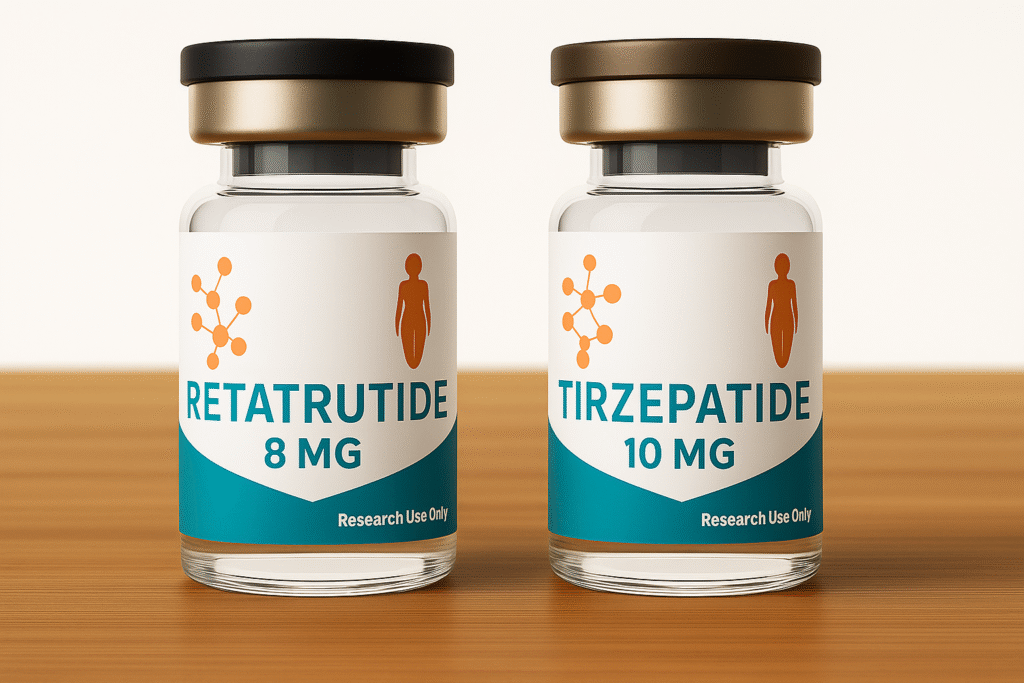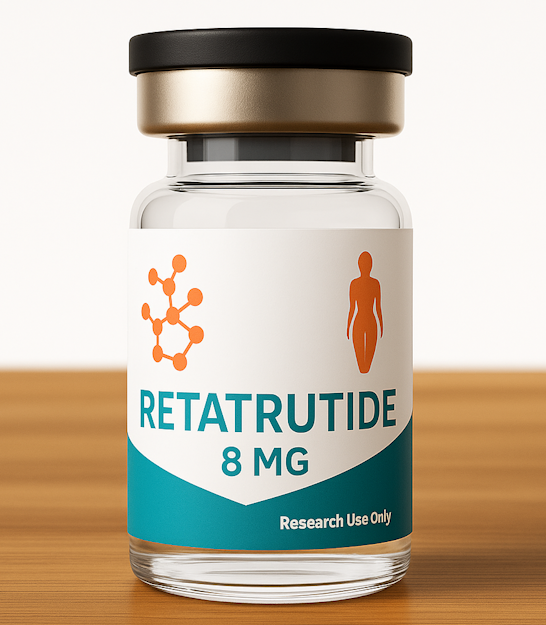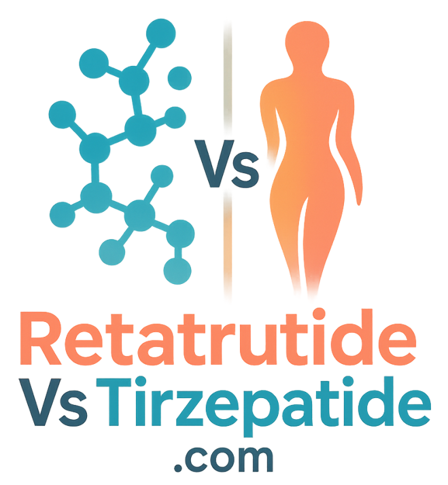Retatrutide vs Tirzepatide: Understanding Their Unique Benefits
Discover how we compare Retatrutide and Tirzepatide to empower your health decisions.

Discover Distinct Advantages and Effective Solutions
Dive deep into the comparative strengths of Retatrutide and Tirzepatide, uncovering how each peptide impacts health outcomes and supports wellness goals.
- Comprehensive comparison of peptide mechanisms
- Detailed analysis of clinical benefits and effects
- Insights into safety profiles and side effects
- Up-to-date research and expert commentary

Retatrutide vs Tirzepatide: A New Era in Weight Loss Medications
The growing obesity epidemic has driven demand for more effective weight loss medications, including those that promote weight reduction, that address both body weight and metabolic health. Among the most promising contenders in this new wave of therapies are Retatrutide and Tirzepatide—two medications that are reshaping how healthcare providers approach obesity management and diabetes treatment. While they share similarities, their mechanisms and outcomes differ in key ways. This article will explore the core differences between Retatrutide vs Tirzepatide, examining how these weight loss drugs compare in clinical trials, their effect on blood sugar, and what patients can expect in terms of weight loss results.
What Are Retatrutide and Tirzepatide?
Tirzepatide, marketed under the brand name Mounjaro, is a dual agonist that activates both the GLP-1 and glucose dependent insulinotropic polypeptide receptors. GLP-1, or glucagon-like peptide 1, and GIP, or glucose-dependent insulinotropic polypeptide, are hormones that help regulate insulin secretion, blood sugar control, and appetite.
Retatrutide, on the other hand, is a triple hormone receptor agonist that targets GLP-1, GIP, and the glucagon receptor. This additional pathway—glucagon receptor activation—enhances energy expenditure, potentially offering greater weight loss than Tirzepatide. This triple agonist mechanism represents a novel approach to tackling weight related conditions, particularly obesity and insulin resistance.
Clinical Trials: Promising Results for Both Retatrutide and Tirzepatide
Head-to-head comparisons from recent clinical trials show that both Retatrutide and Tirzepatide lead to significant weight loss and improved glycemic control. However, Retatrutide vs Tirzepatide comparisons suggest that Retatrutide may offer a slight edge in terms of average weight loss.
According to data published in the New England Journal of Medicine, participants using Retatrutide achieved up to 24% reduction in body weight, while those on Tirzepatide saw a maximum of 21%. In a chronic weight management setting, this difference—though modest—may be clinically meaningful.
These promising results highlight the potential of triple hormone receptor drugs like Retatrutide in addressing the obesity epidemic more comprehensively than existing weight loss drugs.
Mechanisms of Action: How These Medications Work
To understand the key differences between Tirzepatide vs Retatrutide, it’s important to examine their mechanisms:
- Tirzepatide: A dual agonist of GLP-1 and GIP, Tirzepatide promotes insulin secretion, improves glucose control, and suppresses appetite. Its GLP-1 activity also contributes to weight reduction by delaying gastric emptying and reducing hunger.
- Retatrutide: As a triple action drug, Retatrutide goes a step further by targeting glucagon receptors, which help increase energy expenditure and fat metabolism. This triple hormone receptor agonist is designed to offer a comprehensive approach to weight loss, especially for those with insulin resistance or diabetes.
Weight Loss Results and Effectiveness
Both medications show remarkable effectiveness as weight loss medications, especially when combined with lifestyle changes. In a recent clinical trial, participants using Retatrutide achieved up to 58 pounds of weight loss, compared to 50 pounds with Tirzepatide at higher doses.
While the margin is small, it still represents greater weight loss compared to previous generations of weight loss drugs such as once weekly semaglutide.
These significant weight loss results highlight how Retatrutide may help patients lose weight more efficiently and sustainably. For many individuals struggling with obesity, such medications offer hope for achieving long-term health goals.
Blood Sugar Control and Diabetes Management
In addition to weight loss, both drugs are highly effective in improving blood sugar control. Tirzepatide, already FDA approved for diabetes management, improves glycemic control by enhancing insulin release and increasing insulin sensitivity.
Retatrutide also shows potential in diabetes care, though it is not yet FDA approved. Early data suggest it has comparable, if not superior, effects on blood sugar and glycemic control, thanks to its added glucagon receptor activation.
Patients with type 2 diabetes may benefit from both Retatrutide and Tirzepatide, but key differences in their mechanisms suggest tha final outcomes will likely depend on individual metabolic health, existing medications, and physician guidance.
Appetite Regulation and Satiety
Another important consideration in the Retatrutide vs Tirzepatide discussion is appetite regulation. Both medications effectively reduces hunger, helping patients feel full sooner and consume fewer calories.
Retatrutide, due to its triple hormone receptor profile, appears to have a stronger appetite-suppressing effect, which may further contribute to its superior average weight loss outcomes. This ability to promote weight loss by altering satiety cues is especially valuable in treating obesity.
Safety, Side Effects, and FDA Approval Status
Tirzepatide is already FDA approved for both weight loss (under the brand Zepbound) and diabetes treatment (as Mounjaro). The most common side effects include nausea, vomiting, and diarrhea, which typically subside over time.
Retatrutide is still under review, with FDA approval anticipated following additional trial phases. While early safety profiles appear favorable, further data are needed to confirm its long-term effects.
Patients should consult a healthcare provider to determine which medication is most appropriate, especially if they are taking other weight loss medications or managing weight related conditions like high blood pressure or high cholesterol.
Brand Names, Availability, and Cost
Tirzepatide is available under the brand names Mounjaro and Zepbound, depending on whether it’s used for diabetes management or chronic weight management. Insurance coverage varies, and out-of-pocket costs can be high without support programs.
Retatrutide is not yet commercially available but is expected to be priced similarly once approved. As with other weight loss medications, the cost will depend on dosage, frequency, and insurance reimbursement.
Who Should Consider These Medications?
Patients who have struggled to lose weight through lifestyle changes alone may benefit from either drug. Individuals with type 2 diabetes, metabolic health issues, or obesity-related conditions should consult a healthcare provider about whether Tirzepatide or Retatrutide is more appropriate.
The two medications share many similarities, but those looking for a more comprehensive approach or who have not seen results with GLP-1 receptor agonist drugs alone may consider Retatrutide once it becomes available.
Frequently Asked Questions
Q: Is tirzepatide stronger than retatrutide?
Not necessarily. While tirzepatide is currently FDA approved and clinically proven to be highly effective for weight loss and blood sugar control, early clinical trials suggest that retatrutide may lead to greater weight loss. In some studies, retatrutide produced up to 24% reduction in body weight, resulting in greater weight loss compared to tirzepatide’s ~21%. However, retatrutide is still under investigation and not yet approved, so direct clinical comparisons are ongoing.
Q: What makes retatrutide better?
Retatrutide is a triple hormone receptor agonist, targeting GLP-1, GIP, and glucagon receptors. This triple action may result in:
- More appetite suppression
- Increased energy expenditure
- Improved fat metabolism
These combined effects could explain the greater weight loss seen in early trials, making retatrutide potentially better for treating obesity and insulin resistance, especially in individuals not responding fully to dual agonists like tirzepatide.
Q: What is the other name for retatrutide?
As of now, retatrutide does not have a commercial brand name because it is still in clinical development. It is referred to by its research name only. Once it receives FDA approval, a brand name (like Mounjaro for tirzepatide) will likely be assigned.
Q: Is retatrutide safer?
Retatrutide has shown a favorable safety profile in early trials, with side effects similar to those of tirzepatide, such as nausea, vomiting, and diarrhea. However, because it is still under investigation, long-term safety data is limited. Until more data is published and regulatory review is complete, it’s too early to definitively say whether retatrutide is safer than tirzepatide.
Final Thoughts on Retatrutide vs Tirzepatide
In the evolving landscape of weight management and weight loss medications, the comparison of Retatrutide vs Tirzepatide represents a leap forward in tackling obesity, insulin resistance, and related conditions. While both are effective in reducing body weight and improving blood sugar control, Retatrutide shows promise as a more potent triple hormone receptor agonist with broader effects.
As more data emerges from the New England Journal and other studies, the gap between Tirzepatide and Retatrutide will become clearer. For now, patients can take comfort in knowing that these medications work, and that a new era of obesity management and metabolic health is well underway.
Comparing Retatrutide and Tirzepatide Insights
Explore key differences and advantages of each peptide.
Mechanism of Action
Discover how Retatrutide uniquely targets multiple receptors.
Clinical Benefits
Understand the health improvements shown in trials for both.
Usage and Dosage
Learn recommended administration and dose variations.
Side Effects
Review common reactions linked to Retatrutide and Tirzepatide.
Research Updates
Stay informed on the latest studies and developments.
Blog
Explore detailed articles comparing Retatrutide and Tirzepatide, offering expert insights, latest research, and practical advice to empower your health decisions.
Retatrutide Versus Tirzepatide: Understanding Their Unique Effects
Subscribe now to receive insightful updates and deepen your understanding of these groundbreaking peptides.
